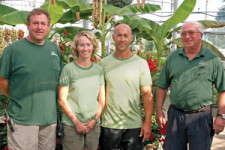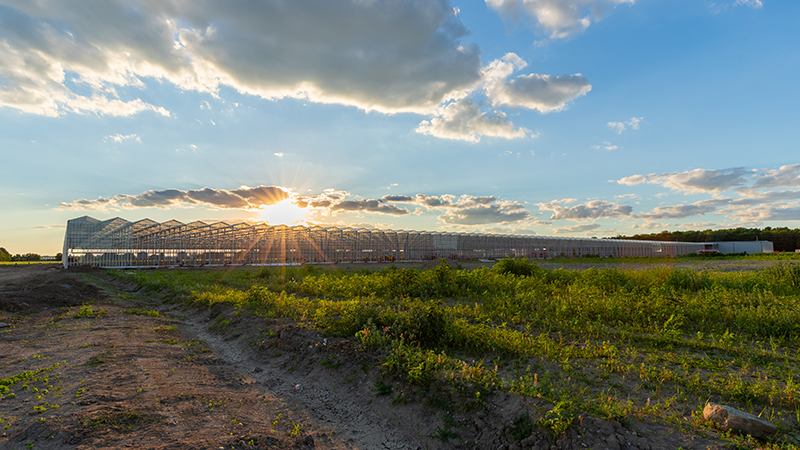Dill Greenhouse Is Making The Most Of A Mature Market

From a stack on his desk, a smudged Post-it note sits scribbled with heirloom tomato names. The task at hand is to decide if the tomato-tasting event at Dill’s Greenhouse should go on. Day-after-day summer downpours and, subsequently, hot temperatures were not kind to the heirlooms this growing season.
Jerry Dill can see his greenhouse business from the retailer’s point of view. He believes he will be as successful as the gardeners who buy from him. If they are not, his greenhouse will lose out. Dill thinks his business is impacted by (in this order): how much weather they get, the economy, what the business does to itself and the ever-maturing green industry.
Without hesitation, Dill says, “Garden retailing and growing is a weather-related business – 2009 proved that. It was one of the best springs weather wise with record sales.” Contrast 2009 to 2011, in which Dill lost 10 percent in sales, and he’ll admit “April killed us.”
Adjusting In Retailing & Growing Plants
Known in the area for its pond plants and equipment, Dill’s Greenhouse has maintained a regular following of customers. But, Jerry cautions, it is a specialty business with little margin for error. Carrying live fish was time consuming and not productive, so he gave it up.
Dill is out of the koi business but he did invest in a large Dingo auger his landscaping team uses to plant the 4-inch caliper trees sold from their nursery. “The guys love it,” he says. “It’s nothing special but we have the equipment for the work we do.”
Dill’s Greenhouse is a full-service and delivery landscaper, the department being managed by a full-time landscape designer. Not focusing on hardscapes, Dill carries most of the plant materials used in its projects. The business started offering landscaping services in 2006, developing it into another revenue stream. But in retrospect, with new construction impacted by the housing bubble, Dill thinks his landscaping business probably started at an inopportune time.
Dill is confident about filling parking lots in April, May and June. It is after July and in the offseason when attracting customers remains the challenge to independent growers like him. While weather is his number one issue, and yes, there is still the economy to worry about, he also feels the industry is maturing and being ruined by overproduction, causing sales growth to stagnate.
It is clear that selling mums in full bloom in mid-July, when his Ohio customers will want them blooming in September and October, is not how Dill wants to run his greenhouse. He knows new is good but what looks good in the greenhouse in May is only one part of the strategy. He wants to know what the plants will look like in mid-summer.
“Breeders should focus on drought tolerant or, should I say, low-maintenance plants,” Dill says.
A Family Business
Upstairs from the main entrance of Dill Greenhouse are the informal offices of Dill and Colleen Sapp, one of his daughters who serves as office manager. Sapp points out a series of photos along one wall depicting Dill’s beginnings preserved in dime-store frames. At the start, she and her sister, Kelly Brandewie, were young girls.
Brandewie is the retail manager for Dill’s Greenhouse and her influence is seen in the eclectic assortment of containers and the dramatic planter combinations popular at Dill’s. In the courtyard, which includes the fish pond and perennial and nursery displays, are the entrances to the retail greenhouses.
Dill’s undergraduate work at Ohio State University was devoted to marketing, not horticulture. But he paid his dues and gained 10 years of experience working for another grower before making his move to owner along with his partner and co-owner, Eileen Dill.
In 1983, he purchased the property of a wholesale greenhouse in Groveport, Ohio. Located off U.S. Route 33 just south of Columbus, Ohio, this destination greenhouse is easy to get to.
Active in the Community
The front entrance of Dill’s Greenhouse has a wide open landscape befitting the neighboring countryside. The asphalt parking lot lays open a welco
In recent years, an addition to the front of the property was an 8-foot-tall and 28-foot-wide outdoor electronic billboard. The massive sign draws its share of curiosity. The screen’s messaging system rotates with traditional garden sales messages, which can be read going eastbound down the highway.
Among Dill’s promotional tools is its website, which features plant lists to help consumers anticipate the new season’s plant selection. Dill’s Dollars are point-of-purchase coupons customers can redeem later in the season on new purchases, and free on-site classes are offered to customers on Saturdays.
Dill’s Greenhouse sells about 50 poinsettia cultivars each year. For more than 10 years, Dill’s has been one of four greenhouses that trial new cultivars for Ohio State University. Dill likes to participate for the chance to see what’s coming out and what’s worth taking a second look at.
The business also offers plants in 6.5-inch pots and larger, selling them to school and church groups.
The Fall Fest is a huge success at Dill’s Greenhouse. It caters to young families with children, fourth grade and younger. There is a corn maze, hay rides and pumpkins to buy. Dill finds the event attracts a different crowd of customers than the early-season crowd.
Customers also like the tomato tasting event, which allows people to try out Dill’s heirloom tomato varieties when the weather cooperates. Dill has taken on selling local farm produce at the business. Partnering with a local farmer, Schacht’s Farm, Dill’s sells its produce at the greenhouse. Dill promotes the Schacht name on the produce.
Dill’s Greenhouse is part of the community. Regular customers come from as far away as German Village in Columbus, plants are donated to the Ohio State Fair and the greenhouse provides hanging baskets to the nearby community of Canal Winchester. However, Dill’s longtime run on the board of the OFA ended this past July.
With a big beaming face, he sums up his outlook on selling plants: “Vegetable sales have been incredible in the last few years, young families are gardening again. It is fun for us to finally have young families come in who have never planted a garden before and ask, ‘Can you help me?’”









